Author: Amanda Ahne
Asset Allocation Bi-Weekly – The Inflation Adjustment for Social Security Benefits in 2024 (November 6, 2023)
by the Asset Allocation Committee | PDF
Social Security was the second-largest contributor to the increase in the fiscal deficit in 2023 (behind only net interest on debt), accounting for $134 billion. Much of the increase in entitlement spending was due to the 8.7% surge in cost-of-living adjustments (COLAs), which was the largest jump since 1981. The purpose of the increase was to compensate entitlement recipients for rising inflation, which peaked at 9.2% in September 2022. However, the inclusion of the COLA has made it difficult for lawmakers to help rein in the country’s burdensome fiscal deficit.
In mid-October, the Social Security Administration announced that Social Security retirement and disability benefits will jump 3.2% in 2024, bringing the average retirement benefit to an estimated $1,907 per month (see chart below). That means the average Social Security benefit will increase by $80 per month in 2024, slightly below the historical average increase of 3.8% and down from an increase of $146 last year. The benefit rise was right in line with expectations, given that it is computed from a special version of the Consumer Price Index (CPI) that is widely available.
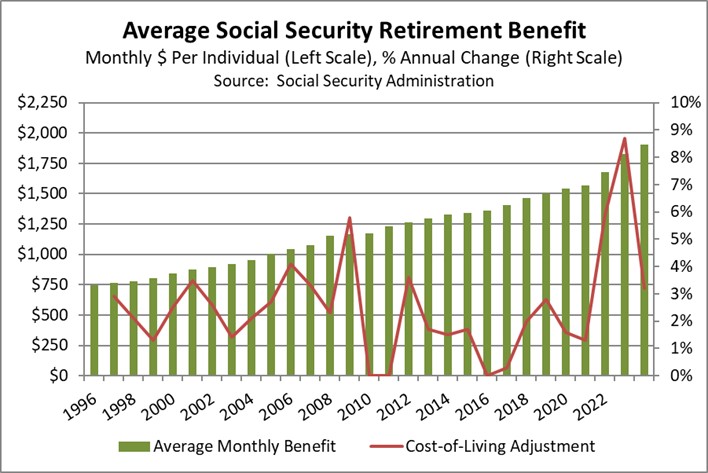
Media commentators often fret that the Social Security COLA could be “eaten up” by rising prices in the following year, or that the benefit boost could provide a windfall if price increases were to slow down. In truth, the COLA merely aims to compensate beneficiaries for price increases over the past year. It’s designed to maintain the purchasing power of a recipient’s benefits given past price changes. The coming year’s price changes will be reflected in next year’s COLA, because high inflation in the current year generally leads to more spending in the following year.
While the tax base is adjusted to compensate for spending increases, the rate does not match the COLA adjustment. For example, the maximum amount of earnings subject to the Social Security tax was hiked to $168,600, up 5.2% from the maximum of $160,200 in 2023. This discrepancy in the percentage increase in Social Security benefits compared to the percentage increase in taxes collected is related to the way these items are calculated. Unlike benefits, the increase in the taxable income is calculated by a national average wage index, which looks at movement in pay. As a result, the increase in the taxable income is used to offset the increase in benefit expenses, especially when the labor market is tight.
For the overall budget, the inflation-adjusted nature of Social Security benefits is particularly important. Since so many members of the huge baby boomer generation have now retired, and since more and more people are drawing disability benefits than in the past, Social Security income has become a bigger drag on the federal deficit (see chart below). In 2023, Social Security retirement and disability benefits accounted for roughly 22.1% of federal net outlays. Having such a large part of the budget subject to automatic cost-of-living adjustments helps ensure that a big part of the deficit will be sensitive to changes in inflation, albeit with some lag.
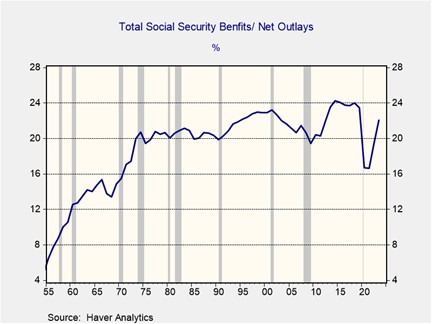
Although socially sensitive, lawmakers must address Social Security’s financial challenges. Politicians have several tactics to reduce the program’s burden on the deficit without cutting benefits, such as raising the retirement age, increasing the Social Security tax rate, and/or using an average rate of inflation over a given period. While unlikely in the next few years, resolving Social Security problems will probably become more of an issue as millennials and Gen Z form more of the voting bloc. Working out the Social Security problem would make the deficit more sustainable and is likely to put downward pressure on Treasury yields, but it could also limit spending in sectors popular with the elderly, such as healthcare and travel, which could stifle economic growth.
Daily Comment (November 3, 2023)
by Patrick Fearon-Hernandez, CFA, and Thomas Wash
[Posted: 9:30 AM EDT] | PDF
Good morning! Equities are surging due to the employment data, and Victor Wembanyama has proved that being tall and mobile makes it easier to score points in basketball. Today’s Comment begins with a discussion on how central bank policy impacts bond yields, examines a new rift over government funding, and concludes with a preview of the Xi-Biden meeting. As always, our report also includes a summary of the latest domestic and international data releases.
Will Rates Stay Down? Declining interest rate expectations have caused longer-duration U.S. Treasury yields to fall.
- Investors seem confident that central banks have finished raising interest rates, with four of the five G-7 rate-setting bodies holding rates unchanged in the past 10 days. The European Central Bank, Federal Reserve, Bank of Canada, and Bank of England have signaled that policy rates may already be sufficiently restrictive to bring down inflation and will take a wait-and-see approach before raising again. This comes after central banks hiked policy rates to multi-decade highs in an effort to restore price stability. The more accommodative stance is due to concerns about a recession as PMI manufacturing readings show that economic output in G-7 countries has slowed.
- This shift in sentiment has increased investors’ appetite for longer-duration assets, such as fixed income and growth stocks. The yield on the 10-year Treasury, a benchmark for global asset prices, has fallen by more than 30 basis points over the last two days, one of the biggest drops since the regional banking turmoil in March. Furthermore, the drop in interest rates also supported an equity rally, with the S&P 500 and Nasdaq Composite rising 3.0% and 3.5%, respectively, since the Fed’s rate decision. Investment-grade bonds also reflected this risk-on behavior, with the Markit CDX North American Investment Grade Index, a gauge of credit risk, falling the most in 10 weeks.
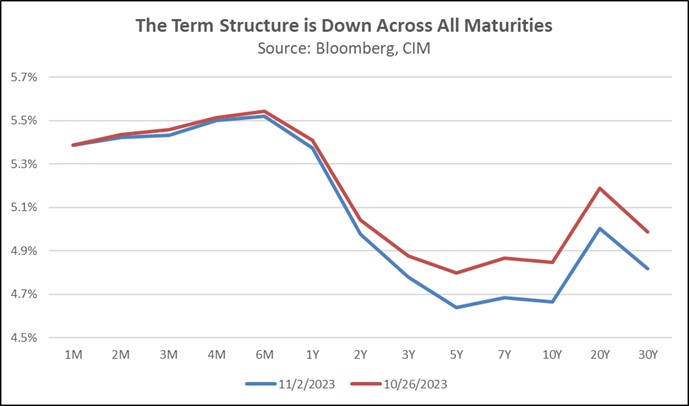
- While central banks have paused rate hikes, this does not signal a readiness to pivot. The Fed has cited tight financial conditions as a reason to keep rates steady, suggesting that policymakers may delay easing even if conditions improve. The recent rally in global bonds means that borrowing costs are starting to fall, thus paving the way for more lending. Moreover, core inflation remains above target in many countries, and progress could be reversed if demand starts to pick up. It is important to remember that bondholders were wrongfooted earlier this year; thus, investors shouldn’t rule out another head fake.
Bidenomics Pushback: New House Speaker Mike Johnson (R-LA) is preparing for a confrontation with the Biden administration over the president’s flagship legislation.
- The U.S. House of Representatives passed a bill on Thursday to provide $14.3 billion in aid to Israel and cut funding for the Internal Revenue Service. Despite its slim chances of passing the Senate or surviving a White House veto, the bill signals a shift in stance as the two parties prepare for another round of talks on the U.S. government budget. The move to tie military aid to spending cuts is an unusual gambit, given that providing assistance to allies has typically been bipartisan and without conditions. However, Johnson’s latest ploy will likely further divide Congress as the two sides look to prevent a government shutdown on November 17.
- Johnson’s insistence on spending cuts suggests that Republicans’ ultimate strategy in budget talks is to rein in the recent spending packages passed by Congress. The Inflation Reduction Act’s $80 billion increase in funding for the IRS was designed to give the agency more tools to pursue tax evaders. According to the Congress Budget Office, the investment should increase government revenue by approximately $200 billion and lead to a net deficit reduction of $114 billion over 10 years. Its inclusion in the IRA passed in 2022 was designed to offset much of the increased deficit spending included in the legislation. As a result, the lack of funding suggests that Democrats will have to find cuts elsewhere if they want to keep initiatives intact.
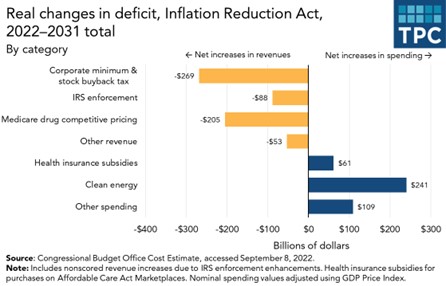
- Controlling the federal budget deficit is likely to play a key role in the upcoming presidential elections. Over the past five years, the country has seen an unusually sharp rise in spending due to the pandemic response, funding for clean energy, and tax cuts. The position by House Speaker Johnson suggests that he plans to push for more spending cuts to resolve the budget shortfall, while Democrats in the Senate are likely to push for tax increases to fill the gap. The upcoming elections could hinge on whether the country is willing to give up Trump’s tax cuts, which expire in 2025, or fund Biden’s energy transition, which will require significant spending in 2024.
U.S. and China Face Off: Leaders of the largest economies are set to meet in San Francisco on Monday in an effort to dial back tensions.
- The two leaders will focus on the deteriorating U.S.-China relationship, which is evident in China’s growing assertiveness in the Indo-Pacific, close ties to Russia, neutral stance on the Israeli-Palestinian conflict, and other issues. While the meeting is unlikely to produce any breakthroughs, the hope is that it will allow the leaders to put their differences on the table and prevent miscalculations that could lead to conflict. Last week, President Biden reaffirmed the U.S. government’s commitment to defending the Philippines in the event of an attack by China in the South China Sea. Beijing responded by warning the United States to stay out of other countries’ affairs.
- Despite factions in both countries that favor cooperation, the U.S. and China appear to be drifting apart. American companies still rely heavily on China for sales growth. For example, Apple (AAPL, $177.57) shares fell 3.0% after reporting weak sales in China, the world’s second-largest economy. At the same time, Chinese factories could lose market share to foreign competitors due to U.S. reshoring efforts. Nevertheless, the de-risking trend is accelerating as evidenced by the 14% decline in Chinese holdings of U.S. Treasury securities and the sharp drop in U.S. imports of Chinese goods and services to their lowest level since late 2020.
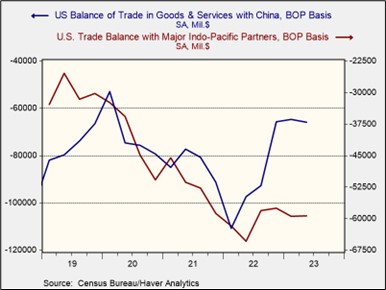
- The divorce between the world’s two largest economies is likely to unfold over the next few years, with the biggest impact on large companies with significant revenue exposure abroad. Small and medium-sized businesses, which are typically domestically focused, are somewhat insulated from the uncertainty surrounding the U.S.-China relationship. However, countries such as Mexico and Poland are well-positioned to take advantage of the shift as they have the manufacturing capacity and skilled labor needed to fill the output void from companies looking to reduce their reliance on China.
Daily Comment (November 2, 2023)
by Patrick Fearon-Hernandez, CFA, and Thomas Wash
[Posted: 9:30 AM EDT] | PDF
Good morning! Equities are off to a great start and the Texas Rangers are the new World Series champions. Today’s Comment starts with a discussion about the latest FOMC meeting, followed by our thoughts on the dollar, and an update on the bomb cyclone that is expected to make landfall in Europe. As always, our report includes an overview of the latest domestic and international data releases.
No More Hikes? Markets bet on peak policy rates after the Federal Open Market Committee (FOMC) voted to hold rates at a 22-year high.
- Fed policymakers held rates steady at 5.25% to 5.50% at their October 31-November 1 meeting, citing concerns about tighter financial conditions. The announcement comes just over a week after the 10-year Treasury yield exceeded 5% for the first time since 2007. At the press conference, Fed Chair Jerome Powell reiterated the central bank’s commitment to a 2% inflation target and said it remains prepared to raise rates if economic conditions warrant, adding that officials are not considering cutting rates anytime soon. However, he said the committee expects the economy to show signs of weakening as interest rates take hold.
- Markets cheered Powell’s remarks, with the S&P 500 closing up 1.0% on Wednesday and bonds rallying across the curve, with the yield on the 10-year Treasury falling 18 bps. Though some of the sentiment was driven by the Treasury’s decision to slow the pace of long-dated bond issuance, there was also hope that the Fed officials were finished with their hiking cycle. The CME FedWatch Tool now projects an 84.5% chance of steady rates in December and a nearly 70% chance of a rate cut by June 2024, up from 69.1% and 50.6%, respectively, last week.
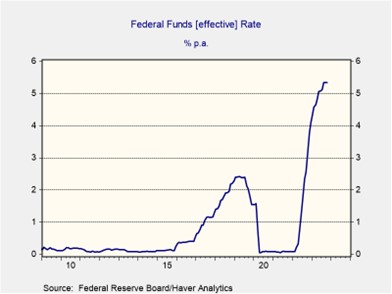
- The Federal Reserve will keep its options open over the next few months, but all signs suggest it is done raising interest rates. Policymakers are likely to focus their efforts on making sure that rates do not remain too high for too long and begin impacting the real economy. So far, the Fed has been fortunate in keeping rates high for a sustained period without any negative consequences. However, it is unclear how long this good luck will last. Current default rates suggest that the default spread should be wider, indicating that investors are not adequately pricing in risk. This may change as more debt approaches maturity and needs to be refinanced at higher interest rates.
Greenback’s Resistance: After months of persistent growth, momentum in the U.S. dollar is showing signs of waning.
- Technical analysis shows that the U.S. Dollar Index has breached its 20-day moving average of 106.25, suggesting that the dollar trend may be close to reversing. The index has hovered in the 106-107 range over the past month, lacking upward pressure as market participants anticipate that central banks around the world are entering a new phase in their monetary policies. This lack of exchange rate movement comes as the market grows more confident that the policy rate differential between the Federal Reserve and its peers will not widen over the next few months.
- Over the past week, policymakers have signaled their reluctance to outdo the Fed in dovishness. The European Central Bank, the Bank of England, and the Bank of Canada all voted to hold rates steady for the second consecutive meeting, while the Bank of Japan took steps toward policy tightening. This cautious approach to a policy pivot reflects concerns that inflationary pressures may return if policymakers ease prematurely. Swap markets show that most central banks are expected to hold rates steady until the end of the year but may hike again in the first quarter of 2024.
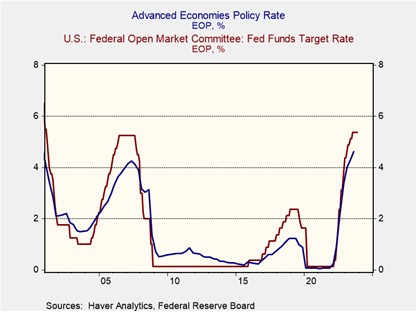
- Historically, the Federal Reserve has hiked and eased more aggressively than its peers, suggesting that if the Fed is indeed done, then the downtrend in USD may start to take hold. This trend could benefit international equities as it should ease the debt burden and inflation pressures of countries that have exposure to the dollar. That said, investors should not become complacent as persistently strong economic data could lead the Fed to restart its hiking cycle, which would lead to renewed strength in the dollar. A weak jobs report on Friday should be enough to convince investors of a sustained trend, but another upward surprise may encourage investors to await more guidance from the Fed before abandoning their USD positions.
European Bomb Cyclone: A rapidly intensifying storm heads toward Europe this week, compounding its economic woes.
- Extreme Storm Ciarán is expected to make landfall in Britain first, becoming the first major country to be hit by the storm. The U.K. Met Office has warned of violent winds and possible flooding in several areas in the country. Afterward, the storm is expected to make its way to France carried by a “sting jet,” which is expected to lead to severe winds with speeds up to 130 km/h. Meanwhile, southern European countries such as Spain and Portugal are also expected to be impacted by strong winds. The storm has led to preemptive measures such as school closures as they prepare for the storm’s potential damage.
- These adverse weather conditions are coming at a bad time for Europe. Despite better-than-expected inflation data in October, with CPI falling below 3% for the first time since August 2021, economic activity in Europe has started to slow. GDP growth for the third quarter contracted at a seasonally adjusted annual rate of 0.1%, driven by a sharp decline in exports. The storm will likely lead to further economic disruptions, but any necessary rebuilding from the destruction could lead to a pickup in activity.
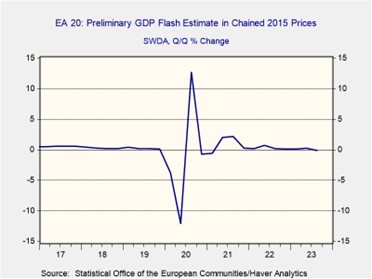
- Natural disasters are typically detrimental to local areas as opposed to the overall country, but the impact may vary depending on the event. There are several factors that influence the possible scale of the weather event, including the magnitude and duration of the event, the structure of the local economy, the population base, and the time of day the event occurs. That said, even in the case of major events, costs are typically overstated. In short, this storm may cause short-term disruptions, but it is unlikely to have a lasting impact on the growth prospects of Europe.
Other news: President Biden has asked the Israeli government to halt its forces to help with the hostage situation. The announcement highlights the potential risks of violence escalating throughout the Middle East.
Weekly Energy Update (November 2, 2023)
by Bill O’Grady, Thomas Wash, and Patrick Fearon-Hernandez, CFA | PDF
Crude oil prices are off their recent highs on expectations that the Hamas crisis will remain contained.
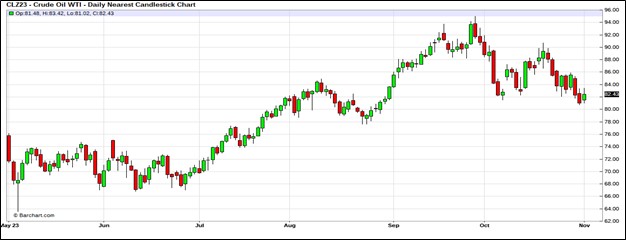
(Source: Barchart.com)
Commercial crude oil inventories rose 0.8 mb compared to forecasts of a 2.0 mb build. The SPR was unchanged, which puts the net build at 0.8 mb.
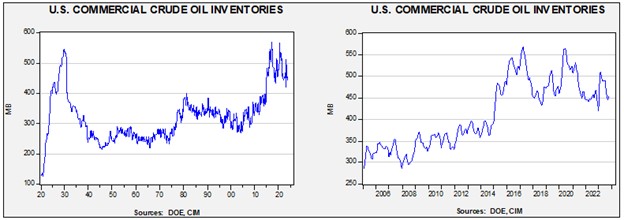
In the details, U.S. crude oil production was steady at 13.2 mbpd. Exports rose 0.1 mbpd, while imports increased 0.4 mbpd. Refining activity fell 0.2% to 85.4% of capacity. Refinery activity remains low but is in line with seasonal norms.
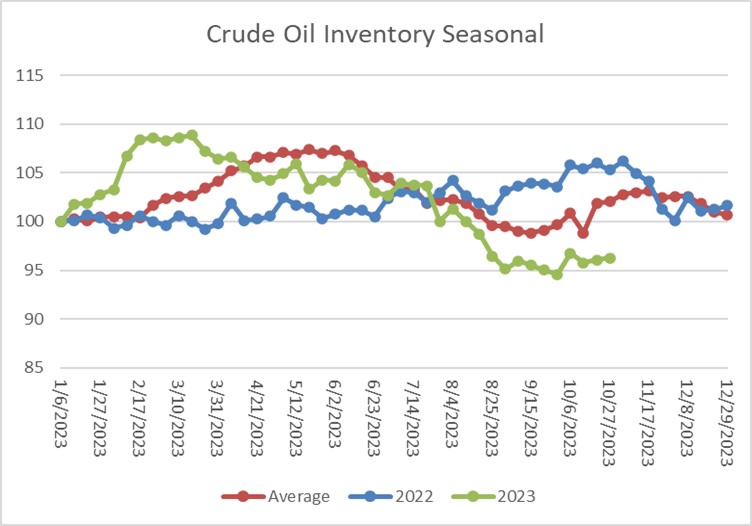
(Sources: DOE, CIM)
The above chart shows the seasonal pattern for crude oil inventories. We continue to see lower-than-normal inventory accumulation.
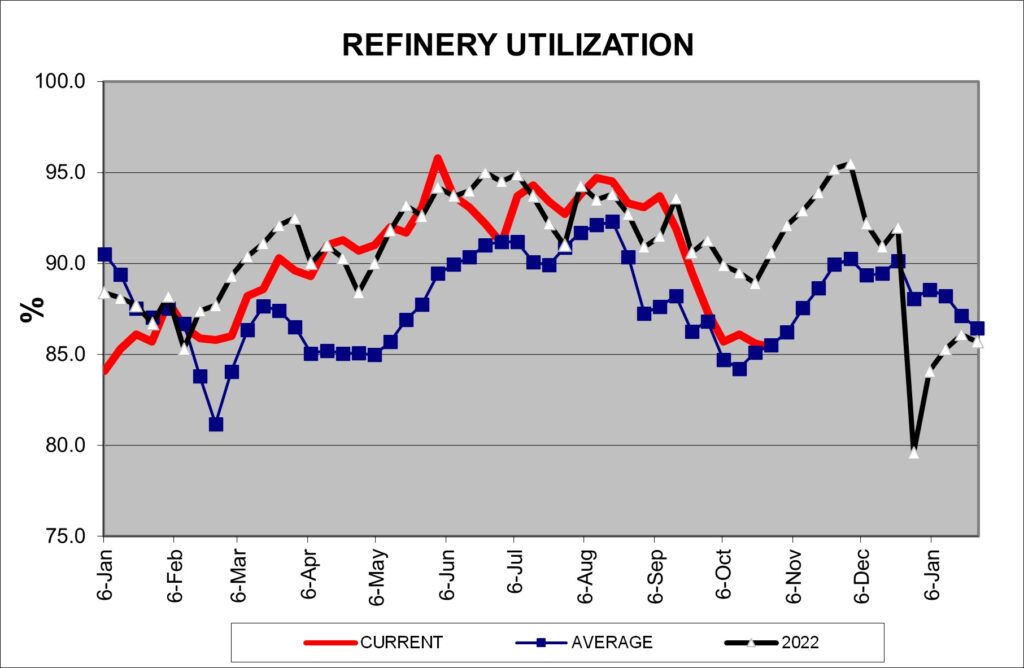
(Sources: DOE, CIM)
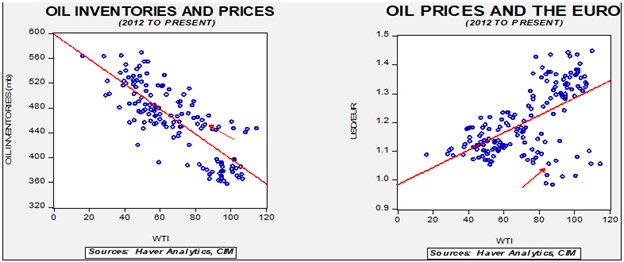
Fair value, using commercial inventories and the EUR for independent variables, yields a price of $73.61. However, given the level of geopolitical risk in the market, we are not surprised that oil prices are well above this model’s fair value.
Since the SPR is being used, to some extent, as a buffer stock, we have constructed oil inventory charts incorporating both the SPR and commercial inventories.

Total stockpiles peaked in 2017 and are now at levels last seen in late 1984. Using total stocks since 2015, fair value is $94.20.
Market News:
- The preliminary meetings for the COP28 meeting in Dubai are underway. Reports suggest the talks are strained. In general, the issue is who will pay for the energy transition. We note that President Biden has declined to attend, suggesting the meeting won’t attract decision makers.
- One of the challenges for energy companies, regardless of whether they are in the fossil fuel or alternatives industry, is policy volatility. In other words, changes in administrations can lead to wide shifts in policy, making investing difficult. Already we are hearing that an element of the GOP wants to scale back Biden-era policies on alternative energy investments. Even if the GOP does win in 2024, there’s no guarantee that the party will prevail in 2028, meaning that investment policy could change again in a few years. Thus, structuring long-term investments is becoming an increasing problem.
- The DOE is warning that the U.S. is behind on expanding the grid to handle increased electrification.
- Another issue is that policy goals can occasionally conflict. The administration is considering banking policies that would require banks to increase their capital, which may cause banks to curtail lending on alternative energy projects that are considered risky.
- An aging oil tanker anchored about 15 miles off the cost of Nigeria exploded earlier this year, a reminder that the fleet Russia is using to evade sanctions could be creating similar risks.
- As we have noted in recent issues, EU natural gas storage is essentially full. As gas flows continue, operators are increasingly storing gas in Ukraine despite the obvious risks.
- Low water levels may lead to higher propane prices this winter. Because of these water levels, large vessels can’t pass through the Panama Canal, forcing operators to use smaller vessels which increase costs.
Geopolitical News:
- We continue to closely monitor the situation in Gaza; so far, the conflict remains contained, although the recent Israeli incursion does show signs of expanding. However, we note that the U.S. has warned Iran against targeting American troops in the region. There is also legislation being drafted to further punish Iran, and it appears to have bipartisan support. If Iran faces a crackdown, it may lead to a drop in oil supplies. Although we expect the war to be contained, history does show examples of such conflicts unexpectedly widening. Thus, some degree of war premium should remain in oil prices.
- The Kingdom of Saudi Arabia has put its forces on high alert after border clashes and missile incursions from the Houthis in Yemen. The Houthis are an Iranian-sponsored group that has been a participant in the civil war in Yemen. As part of this conflict, it has attacked Saudi Arabia. It is unclear if these recent attacks are related to the Hamas issue in Israel, but it may signal a broadening of the conflict. We note the Houthis claim to have launched missile strikes against Israel.
- Another young Iranian woman has died in custody after security officers arrested her for hijab violations. A similar situation led to widespread protests last year, and there are reports of renewed protests.
- The World Bank’s baseline case for 2024 is for weaker energy prices, with the caveat that elevated geopolitical risks could trigger sharply higher prices.
- The U.S. is concerned that Iran or its proxies will attack U.S. troops in the Middle East. This report discusses where these troops are domiciled.
- Qatar has sentenced eight former Indian naval officers to death on allegations they were spying for Israel. Qatar is a major natural gas producer and is the largest LNG supplier to India. The allegations appear to have caught India by surprise, and so if diplomatic efforts fail, it could affect the natural gas trade between the two nations.
- Russia is trying to redirect its piped natural gas sales to China despite most of its infrastructure being directed toward Europe. There is one large pipeline to China—the Power of Siberia. Russia has a second pipeline on the drawing board, but China has been reluctant to invest in the project for a number of reasons. First, it has been improving relations with Central Asian nations that can also supply natural gas. Second, because it also gets LNG, it may not need the Russian natural gas…unless the terms are very attractive. And so, Beijing is driving a hard bargain with Moscow.
- China announced new export controls on graphite, a key mineral in the energy transition. Although we haven’t heard of actual restrictions yet, the fear is that Beijing has created the bureaucratic infrastructure to restrict it in the future.
- Washington has been in talks to further ease sanctions on Venezuela in return for open elections. However, recent actions by Venezuelan courts to thwart the opposition’s ability to choose its candidates is raising concerns that the Maduro government may not uphold its promises of free elections. If the Maduro government fails, it is less likely that Caracas will get much sanctions relief.
- In local Colombian elections, the leftist Petro administration suffered serious losses. If these elections portend a change in government in the national elections scheduled for 2026, it could bring a return of right-wing governments, which have traditionally supported Colombia’s fossil fuel industry.
Alternative Energy/Policy News:
- As the UAW strikes wind down, it appears the union was able to get concessions on unionizing battery plants. The union had been afraid that these plants would be built in non-union states to reduce costs. If these reports are accurate, it’s a big win for the UAW, but it might make EVs more costly.
- As we have been reporting, solid state batteries offer the promise of rapid recharging and extended range. In fact, such batteries might be necessary to encourage drivers to switch away from gasoline engines. This report is a primer on these batteries.
- Automakers are reporting slower sales of EVs. It is possible we have reached the point where the committed buyers have acquired a vehicle and new buyers will be purchasing based on perceived value between EVs and gasoline vehicles.
- Toyota (TM, $175.140) announced a major investment in a North Carolina battery plant. In general, investment in EVs in North America has increased with the passage of the Inflation Reduction Act.
- Although metals will be critical to the energy transition, investors continue to shun the mining sector due to its “dirty” reputation. If this attitude doesn’t change, the energy transition won’t occur.
- Uranium demand has hit a 10-year high as nuclear power expands.
- Wind power projects have fallen into disfavor. Higher interest rates, increased costs of materials and labor, along with local opposition are leading to cancellations of projects.
- Carbon dioxide pipelines have run into significant opposition. Without pipelines, carbon capture projects are less likely to go forward.
- The U.S. is working to assure the EU that the Biden administration’s energy policy is not protectionist.
- Seattle is becoming a hotbed for the fusion industry.
Note: The DOE is making system upgrades and indicates it won’t publish data next week, meaning the next edition of this report will be published on November 16.
Daily Comment (November 1, 2023)
by Patrick Fearon-Hernandez, CFA, and Thomas Wash
[Posted: 9:30 AM EDT] | PDF
Our Comment today opens with new examples of how the Chinese Communist Party and government are intruding ever-more strongly into the economy. We next review a wide range of other international and U.S. developments with the potential to affect the financial markets today, including the latest on the Israel-Hamas conflict, its implications for other countries, and a word or two about the Federal Reserve’s latest decision on interest rates, which is due today.
Chinese International Data Regulation: The Ministry of State Security yesterday said it has discovered and “dealt with” hundreds of foreign-run meteorological installations across the country that have been illegally transmitting weather data overseas in real time. The MSS announcement is the latest example of how China is clamping down on even seemingly innocuous information flows out of the country. Some of the weather monitoring equipment discovered and shut down simply appeared to serve foreign weather services and crop monitoring companies.
- More broadly, the clampdown on information flows is part-and-parcel of the global fracturing we have been writing about. As the world fractures into relatively separate geopolitical and economic blocs, we are seeing increased impediments to inter-bloc trade, investment, technology, data, and travel flows.
- As we have been arguing, new impediments to the international flow of merchandise, services, money, information, and people will likely lead to higher and more volatile inflation, interest rates, and production costs worldwide.
Chinese Financial Industry Regulation: With the completion of its quadrennial policy conference on the financial industry, the government yesterday stressed the need to tighten regulation over the sector and “adhere to the centralized and unified leadership of the Communist Party in financial work.”
- Along with the clampdown on sending weather data abroad, the statement on financial regulation helps clarify that China’s economy isn’t just being held back by the “Four Ds” that we’ve discussed previously, i.e., weak consumer demand, high debt levels, poor demographics, and foreign decoupling.
- Now, we would add another “D” to the list of problems, i.e., disincentives arising from government and party interference in company activities.
India: Apple (AAPL, $170.77) has reportedly notified several opposition lawmakers, journalists, and think tank leaders in India that “state-sponsored attackers” are trying to compromise their iPhones. Although Apple didn’t identify what country was sponsoring the attempted hacking, the news has rekindled concern that Prime Minister Modi’s government is trying to spy on its opponents.
- Modi is being increasingly dogged by concerns that he has developed an authoritarian, anti-democratic governing style. For example, his Hindu nationalist program has included a sharp crackdown on Muslims in the northern territory of Kashmir, a ban on foreign donations to a Christian charity founded by Mother Teresa, and a block on the social media accounts of opposition leader Rahul Ghandi.
- Along with accusations that Indian government agents recently killed a Sikh separatist leader living in Canada, these accusations could slow the U.S.’s effort to cozy up to Modi and enlist his help in countering China’s increased geopolitical aggressiveness.
Israel-Hamas Conflict: The Israel Defense Force yesterday said it launched airstrikes against a residential area in the northern Gaza Strip that killed a Hamas commander and many other fighters affiliated with the terrorist group. In a measure of the relative death tolls involved in the fighting, medical officials in Gaza said dozens of civilians died in that one attack, while the IDF said two Israeli soldiers were killed in fighting around the compound. The continued high civilian death toll relative to the number of Hamas fighters killed could further erode foreign political support for Israel as it continues its campaign in Gaza. Separately, attacks on Israeli interests by Islamists in the West Bank, Lebanon, Syria, and Yemen—along with Israeli retaliatory strikes—continue to raise the risk of a broader regional conflict.
- In the U.S., Federal Bureau of Investigation director Christopher Wray yesterday warned that the Hamas attack on Israel last month has raised the risk of a copycat attack on the U.S. “to a whole other level.”
- In France, police on high alert for Islamist terrorism yesterday shot an unarmed woman in a burka at a Paris train station after passengers reported that she was acting in a threatening manner.
United Kingdom: Just as the Israeli-Hamas conflict has exposed sharp divisions within the Democratic Party in the U.S., the leader of the Labor Party in the U.K., Keir Starmer, is dealing with sharp divisions in his party. Some Labor officials are furious at Starmer for his focus on Israel’s right to self-defense. They want him to show more sympathy for the Palestinians and call for a ceasefire. However, Starmer is resisting that pressure so far as he tries to steer his party back toward the political center. The row threatens to erode Labor’s big advantage in recent opinion polls.
Canada: A monthly measure of gross domestic product shows it was essentially flat in both July and August, while other data points to another soft month in September. The figures imply that Canadian GDP may have fallen at an annualized rate of 0.1% in the third quarter, after declining at a rate of 0.2% in the second quarter.
- Not only would that imply a mild technical recession, but it would suggest that Canada, like Europe, is now growing much more slowly than the U.S. As a reminder, an initial estimate of U.S. GDP indicates it rose at a robust 4.9% clip in July through September.
- Higher economic growth and higher interest rates in the U.S. versus Canada implied continued weakness in the Canadian dollar (CAD). Over the last three months, the currency has steadily weakened to the point where it now takes 1.3866 loonies to buy one U.S. dollar.
U.S. Monetary Policy: The Fed wraps up its latest policy meeting today, with the decision due to be released at 3:00 PM EDT. Investors are nearly unanimous in thinking the policymakers will hold the benchmark short-term interest rate unchanged at 5.25% to 5.50%. The focus will therefore be on any guidance regarding future rate changes in the committee’s statement or in Chair Powell’s post-meeting press conference.
- No new economic projections are due to be released at this meeting.
- Nevertheless, the statement and Powell’s discussion could well express a bias toward further tightening, consistent with Powell’s “higher for longer” mantra.
- We think it makes sense to take Powell at his word. Even though we think U.S. interest rates are probably near their peak, we continue to believe the Fed will try to hold them at elevated levels for an extended period to wring inflation out of the economy.
U.S. Residential Real Estate Market: A federal jury yesterday found the National Association of Realtors and several top real estate brokers guilty of illegal collusion to inflate commissions on real estate transactions. If upheld on appeal, the decision in the class-action lawsuit could scuttle the longstanding practice in which home sellers pay a 6% commission to their agents, which in turn is shared with the buyer’s agent without the buyer knowing how much their agent is going to make on the transaction.
U.S. Consumer Sentiment: Wall Street Journal columnist Greg Ip today has an interesting article exploring why consumer optimism is so low when economic growth is humming along, unemployment is low, and wage gains are outpacing price inflation again. Ip’s graph below shows just how low the University of Michigan’s consumer sentiment index is now compared with its past relationship to the “misery index” (the unemployment rate plus the inflation rate as measured by the consumer price index). Ip posits that today’s low consumer optimism may in part reflect dissatisfaction with broader national issues, such as political polarization.
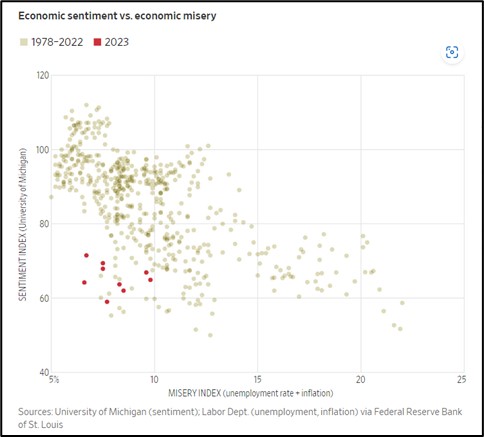
Daily Comment (October 31, 2023)
by Patrick Fearon-Hernandez, CFA, and Thomas Wash
[Posted: 9:30 AM EDT] | PDF
Our Comment today opens with a note about the Pentagon’s annual report on Chinese military power. We next review a wide range of other international and U.S. developments with the potential to affect the financial markets today, including the latest on the Israel-Hamas conflict, a loosening of the Bank of Japan’s yield-curve control policy, and what to expect from this week’s Federal Reserve policy meeting.
Chinese Military Power: As is usual at this time of year, the U.S. Department of Defense last week released its annual report on Chinese military power, which is the basis for much of our analysis regarding U.S.-China relations (and our popular in-person presentation on global fracturing, geopolitical blocs, and their investment implications, which we provide to financial advisors and their clients all over the country). The DOD report does a deep dive into all aspects of Chinese military power, and we’ll be incorporating the latest information in our writings and presentations over the coming weeks. Today, we want to stress that the report also provides a useful discussion of what’s driving Chinese leaders. As we continually write about the increased geopolitical aggressiveness of General Secretary Xi and the rest of the Chinese Communist Party, and how that has ushered in a new, riskier era for investors, the DOD report helps explain why they’re acting the way they are. As you read our discussions of China, we encourage you to keep in mind the following:
- In both public pronouncements and private documents, Xi and the CCP have said that their overarching mission is to achieve the “great rejuvenation of the Chinese nation” by 2049 (the centenary of the People’s Republic of China). This mission encompasses:
- Reclaiming China’s traditional status as the world’s richest, most powerful, most culturally advanced nation, and
- Erasing the “Century of Humiliation” from the mid-1800s to the mid-1900s, when China was dominated and nearly dismembered by foreign powers.
- To achieve their mission, Xi and the CCP have adopted the following priorities:
- Defending and advancing sovereignty, especially over Hong Kong and Taiwan,
- Ensuring the security of China, and of the CCP’s rule, and
- Protecting China’s economic development
- To achieve the “great rejuvenation” by 2049, Xi and the CCP have selected certain subsidiary and interim goals, including:
- Protect the CCP’s monopoly on power,
- Develop the economy and become a technology leader,
- Revise the global political and economic system to serve China’s rejuvenation,
- Leverage tribalism, i.e., the sense that “East is rising, West is declining,”
- Create a global “community of shared future” dependent on China, and
- Build a “world class military” that can “fight and win” wars, including a conflict with a “strong adversary” (a euphemism for the U.S.), by 2049.
- Finally, we note that these missions, priorities, and goals stem from deeply ingrained, longstanding instincts that have evolved over millennia to help humans survive in a dangerous, challenging world: the drive for status, the resistance to being dominated, the sense of security that comes from being a part of a strong group, and the motivation that comes from casting the adversary group as evil (in-group vs. out-group thinking). To the extent that Xi and the CCP are operating on the basis of these deep motivations, China’s new aggressiveness is likely to be long-lasting and could extend even to the point of conflict with the U.S. and its evolving geopolitical bloc, with big implications for investors.
Chinese Economic Growth: The official purchasing managers’ index for manufacturing declined to 49.5 in October, down from 50.2 in September. The PMIs for construction and services also fell, leaving the October composite PMI at just 50.7. Like most major PMIs, the official Chinese gauges are designed so that readings above 50 point to expanding activity.
- At their current levels, the figures suggest the Chinese economy continues to struggle against headwinds such as weak consumer demand, high debt, poor demographics, and foreign decoupling.
- Given the huge size of China’s economy, its current weak growth will likely be a headwind for businesses around the world. That could help mollify global inflation pressures, but it could also take some wind out of global asset values.
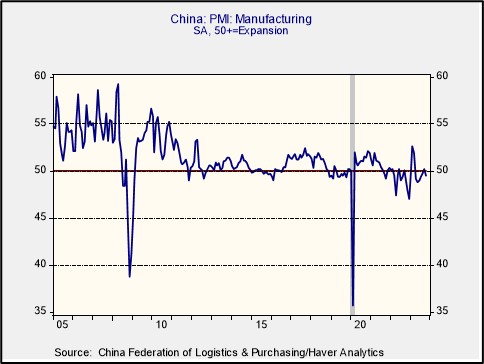
Israel-Hamas Conflict: Dashing hopes for a more limited ground offensive, the Israel Defense Forces have ratcheted up their infantry attacks and airstrikes on Gaza over the last 24 hours. IDF tanks, troops, jet fighters, and other forces are actively engaging Hamas fighters in a wider area of the enclave, with a focus on destroying the extensive tunnel network used by Hamas to hide and protect its fighters and move supplies and equipment from place to place. Along with Islamist attacks on Israel from Lebanon and Syria, and retaliatory Israeli strikes against them, the risk of the conflict spreading regionally remains.
Venezuela: The country’s top court, which is packed with supporters of the authoritarian Maduro government, has “suspended” the opposition’s recent primary election, throwing a wrench into the recent deal in which Venezuela agreed to allow free and fair elections next year in return for the U.S. to relax sanctions on its energy industry. If the move prompts the U.S. to reimpose its sanctions, it could lead to new oil supply challenges and put upward pressure on prices.
Eurozone: Third quarter gross domestic product fell at a seasonally adjusted, annualized rate of 0.4%, erasing most of the annualized 0.6% increase in the second quarter. In contrast with the U.S.’s third-quarter growth rate of 4.9%, the figures illustrate how the eurozone economy is now faring much worse because of headwinds such as high inflation, rising interest rates, and a crisis of confidence in the face of geopolitical tensions.
- On a more positive note, the eurozone’s October consumer price index was up just 2.9% from the same month one year earlier, after a 4.3% rise in the year to September.
- Excluding the volatile food and energy components, the October Core CPI was up 4.2% year-over-year, compared with 4.5% in September.
Japan: As previewed in our Comment yesterday, the Bank of Japan today held its benchmark short-term interest rate steady at -0.1% but said that it will now consider its 1.0% upper bound for 10-year Japanese government bond yields to be merely a “reference rate” rather than a hard limit. Since investors were looking for a more substantial loosening or even abandonment of the BOJ’s yield-curve control policy, both the 10-year JGB yield and the yen (JPY) fell back after an initial jump. Separately, as if to emphasize that the era of ultra-low consumer price inflation in Japan is over, the policymakers also projected that annual price increases would remain close to 3.0% until 2025.
- The yield on the 10-year JGB ended trading in Tokyo at 0.95%, compared with 0.774% at the end of September.
- The JPY closed at 150.70 per dollar ($0.0066), compared with its September close of 147.85 per dollar ($0.0068).
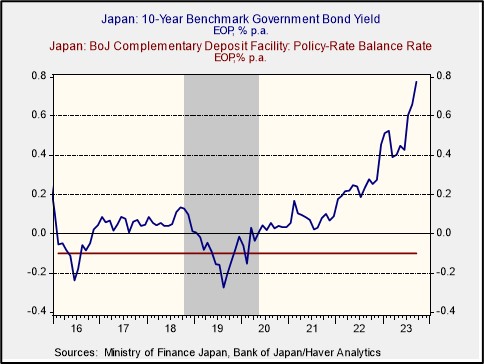
U.S. Monetary Policy: The Federal Reserve begins its latest two-day policy meeting today, with the decision due to be released tomorrow at 3:00 PM EDT. As shown in the chart below, the popular CME FedWatch Tool (based on 30-day fed funds futures prices) indicates investors are nearly unanimous in believing the policymakers will hold the benchmark short-term interest rate unchanged at 5.25% to 5.50%. The focus will therefore be on any guidance regarding future rate changes in the committee’s statement or in Chair Powell’s post-meeting press conference.
- No new economic projections are due to be released at this meeting.
- Nevertheless, the statement and Powell’s discussion could well express a bias toward further tightening, consistent with Powell’s “higher for longer” mantra.
- We think it makes sense to take Powell at his word. Even though we think U.S. interest rates are probably near their peak, we continue to believe the Fed will try to hold them at elevated levels for an extended period to wring inflation out of the economy.
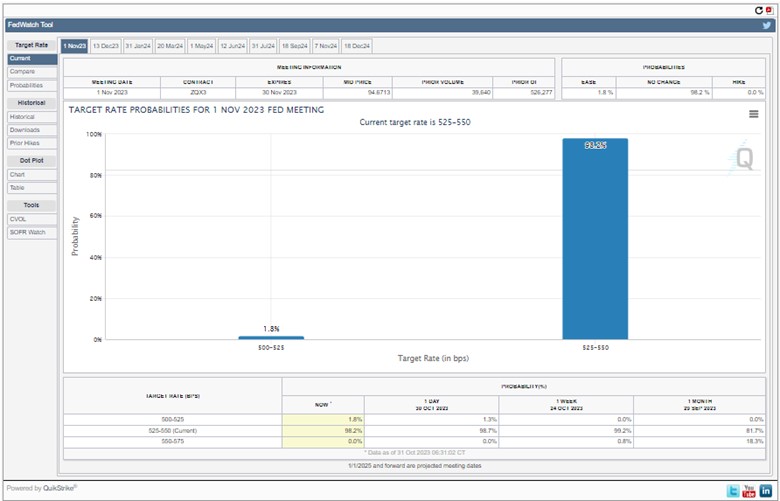
U.S. Regulatory Policy: The Securities and Exchange Commission is suing information technology company SolarWinds (SWI, $9.31) in connection with the company’s failure to stop Russian hackers from infiltrating its systems, a scandal discovered in 2020. According to the SEC, the company mislead investors about its cybersecurity and failed to disclose known risks. The lawsuit illustrates how cyber breaches not only put companies at operational and reputational risk, but also at regulatory risk.
U.S. Commercial Real Estate Industry: According to data provider Trepp, net new bank lending for commercial real estate is now growing at historically low levels. Commercial real estate loans held by banks were only up about 1% from the same period one year earlier. Since banks are the top source of funding for the sector, the slowdown in lending bodes poorly for commercial borrowers’ ability to roll over their loans as they come due, probably adding to the stress in the market today and pulling down commercial real estate values even further.
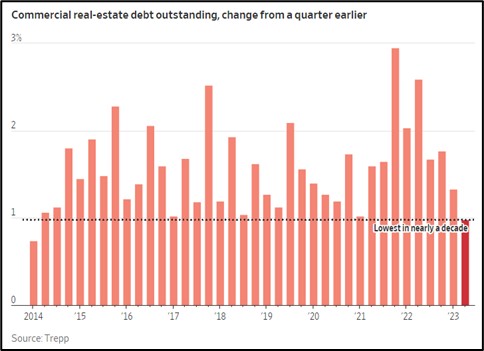
U.S. Auto Industry: As we flagged in our Comment yesterday, the United Auto Workers on Monday struck a tentative deal for a new labor contract with General Motors (GM, $27.36), the last of the Big Three U.S. automakers it was striking. The tentative deals mean that workers at GM, Ford (F, $9.77), and Stellantis (STLA, $18.00) can go back to work immediately.
- If approved by the companies’ UAW workers, the deals will raise wage rates by about 25% over the four-year life of the contracts, improve job security, and increase benefits.
- That will put pressure on the firms to cut other costs, potentially by investing in new labor-saving technologies.
- The deals may also encourage labor organizing, strikes, and higher wage demands beyond the auto industry.
- In any case, the deals will probably add to pressures shifting the share of national income toward workers and away from capital owners.
Bi-Weekly Geopolitical Podcast – #37 “Investment Implications of the Israel-Hamas Conflict” (Posted 10/30/23)
Bi-Weekly Geopolitical Report – Investment Implications of the Israel-Hamas Conflict (October 30, 2023)
Patrick Fearon-Hernandez, CFA | PDF
For investors, geopolitical risks today center on the Great Power competition involving countries like the United States, China, and Russia. Nevertheless, terrorism by non-state actors can still be destabilizing, as shown by the October 7 attacks on Israel by Hamas, the Palestinian terrorist group that controls the Gaza Strip. The attacks resulted in the largest mass killing of Jews since the Holocaust and the seizure of over 200 hostages, prompting the Israeli government to launch military reprisals aimed at destroying Hamas as a political and economic power and raising the risk of a broader regional conflict. This report discusses how the Israeli-Palestinian fighting could play out in the coming weeks and months and what the implications are likely to be for investors.


